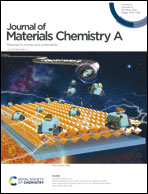Facile modulation of different vacancies in ZnS nanoplates for efficient solar fuel production†
Abstract
Vacancy engineering has attracted intensive attention owing to its great influence on the performance of photocatalysts. So far it still remains a big challenge to controllably modulate various vacancies co-existing in a photocatalyst and unveil the resultant influence mechanism. Herein, the model catalysts of ZnS nanoplates with vacancy defects of VS and VZn–VS–VZn are successfully prepared via a facile annealing approach and are systematically investigated by various techniques. The ZnS nanoplates with more VS defects show much higher photoreduction activity than those with more VZn–VS–VZn defects. The detailed mechanism is elucidated based on the influence of different vacancy defects on the adsorption and activation of the reactants and desorption of the reduction products, as well as on the separation of charge carriers. The reason that ZnS with different majority defects exhibits different photoreduction selectivity is explained according to the differences in the adsorption/desorption among CO2, H2O, H2 and CO.



 Please wait while we load your content...
Please wait while we load your content...